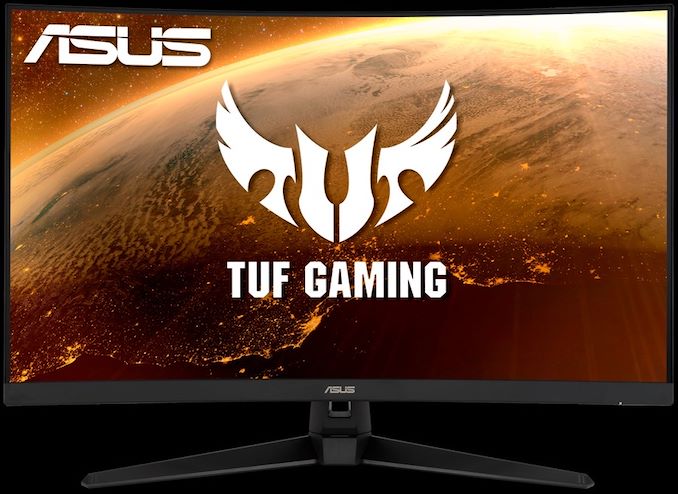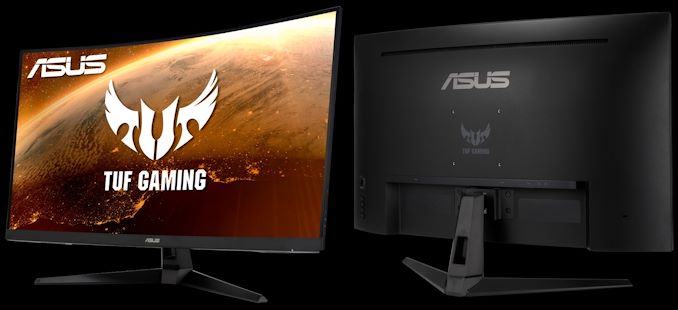Big, Fast, & Curved: The ASUS TUF VG328H1B, A 31.5-Inch Gaming Display
by Anton Shilov on March 2, 2020 4:00 PM EST
ASUS has unleashed a new TUF Gaming display, the 31.5-inch VG328H1B. The mainstream-segment monitor is aimed at gamers who are after a combination of a large screen size, a curved panel, as well as a high variable refresh rate, all without breaking the bank in terms of pricing.
The ASUS TUF Gaming VG328H1B monitor uses a Full-HD (1920 x 1080) VA panel that features a 1500R curvature, a maximum brightness of 250 nits, a 3000:1 contrast ratio, a 1 ms MPRT response time, and a 165 Hz refresh rate in overclocked mode. The LCD can display 16.7 million of colors and reproduce 120% of the sRGB and 90% of the DCI-P3 color gamut, which is in line with other modern gaming monitors. At the same time, considering mediocre resolution and brightness, it is pretty evident that developers of the LCD prioritized size and performance over everything else, keeping in line with the TUF lineup's mainstream focus and pricing.
The display fully supports VESA’s Adaptive-Sync (with a 48 Hz – 165 Hz range) and carries AMD’s FreeSync Premium badge. But while ASUS says that Adaptive-Sync will work with NVIDIA’s latest GeForce GTX/RTX graphics cards, it has not been certified as G-Sync Compatible. In addition, the TUF Gaming VG328H1B supports ASUS’ ELMB and ELMB Sync technologies designed to make fast-paced scenes look sharper (whether or not variable refresh is activated). Other notable features for gamers supported by the monitor are Shadow Boost (increases brightness in dark areas) as well as GamePlus and GameVisual modes.
For connectivity, the TUF Gaming VG328H1B has one D-Sub input as well as one HDMI 2.0 port, which makes for a rather odd set of inputs. Meanwhile, the device has two 2 W stereo speakers, an audio input, and a headphone output.
As for ergonomics, the ASUS TUF Gaming VG328H1B comes with a stand that can adjust tilt and swivel, but not height. For users who need more than that, the monitor has VESA 100x100 holes, so it can use an appropriate third-party arm or stand.
| The 31.5-Inch ASUS TUF Gaming LCD w/165 Hz Refresh Rate | ||
| TUF Gaming VG328H1B | ||
| Panel | 31.5-inch class IPS | |
| Native Resolution | 1920 × 1080 | |
| Maximum Refresh Rate | 165 Hz | |
| Dynamic Refresh | Technology | VESA Adaptive Sync AMD FreeSync Premium |
| Range | 48 Hz - 165 Hz | |
| Brightness | 250 cd/m² | |
| Contrast | 3000:1 | |
| Viewing Angles | 178°/178° horizontal/vertical | |
| Response Time | 1 ms MPRT | |
| Pixel Pitch | ~0.2537 mm² | |
| Pixel Density | ~100 PPI | |
| Color Gamut Support | sRGB: 120% DCI-P3: 90% |
|
| Inputs | 1×D-Sub 2×HDMI 2.0 |
|
| Audio | 2W stereo speakers headphone output audio input |
|
| Stand | Height: - Tilt: +23° ~ -5° Swivel: +/- 15° Pivot: - |
|
| Warranty | ? years | |
| Launch Price | ? | |
Otherwise, while they are announcing the monitor, ASUS isn't disclosing any details about pricing and or availability at this time.
Related Reading:
- Faster & TUFer Gaming: The ASUS VG27WQ 27-Inch 165Hz Curved Monitor w/ FreeSync
- AOC Reveals Agon AG273QX: A 27-Inch 165 Hz FreeSync 2 Monitor
- More Hz for Less: GIGABYTE Unveils Aorus FI27Q 27-Inch 165 Hz Monitor
- ViewSonic Introduces Elite XG270QG Monitor: WQHD w/DCI-P3 and 165 Hz G-Sync
- 28-Inches of TUF Gaming: The ASUS VG289Q 4K IPS Monitor w/ DCI-P3 & FreeSync
Source: ASUS (via Hermitage Akihabara)












18 Comments
View All Comments
sircolby45 - Monday, March 2, 2020 - link
A 1080p monitor at 31.5"?! Why...WinterCharm - Monday, March 2, 2020 - link
I, too, like looking at colorful bathroom tiles.uefi - Monday, March 2, 2020 - link
Also, curved 16:9.kaidenshi - Tuesday, March 3, 2020 - link
Yeah, I'm not a PPI snob by any means (I'm in my 40s so my eyes actually prefer lower PPI) but 1080p at 32" is a television, not a "gaming monitor". My display is 31.5" at 1440p which is the sweet spot for my viewing comfort. I would get fatigued at 1080p on my desk at that size.That, combined with the bizarre inputs; VGA and HDMI...where's DisplayPort? Thunderbolt? Even DVI-D rather than VGA would have been halfway decent. No "gamer" is using VGA output on their machine unless it's a retro build for 2002 era gaming.
PeachNCream - Tuesday, March 3, 2020 - link
It's pretty much over at this point. HDMI is the standard and DisplayPort is not. You will obviously still see DisplayPort-equipped hardawre around, but it never really got adopted widely enough to overcome HDMI's momentum.kaidenshi - Tuesday, March 3, 2020 - link
HDMI is fine, and as you said it's pretty much the standard. It's still nice to have DP as an option without resorting to dongles though. I have an entire drawer dedicated to HDMI > DVI/DP/miniDP/miniDVI/miniHDMI/microHDMI and so on.To me DP is superior to HDMI in one regard: Locking connectors. Better than VGA and DVI's annoying screws, and more secure than HDMI so I don't unplug my display cable every time I need to pull my monitor forward a bit.
star-affinity - Tuesday, March 3, 2020 - link
"I'm in my 40s so my eyes actually prefer lower PPI"What's that supposed to mean? :)
I'm also in my forties now, but can't see how that equals preferring lower PPI.
kaidenshi - Tuesday, March 3, 2020 - link
Smaller fonts are harder to comfortably read. A 32" screen at 1440p is a sweet spot for my vision, anything higher res and I'm squinting or else zooming in far enough to break layouts. On the other side, 1080p at 32" is blurry and I have to zoom out or sit back.inighthawki - Monday, March 2, 2020 - link
32" 1080p VA panel at 165hz.And here I thought that MSI panel looked meh.FYI table has a typo - incorrectly says the panel type is IPS.
Slash3 - Monday, March 2, 2020 - link
Unfortunately, these kind of product posts are never corrected.